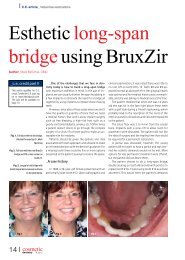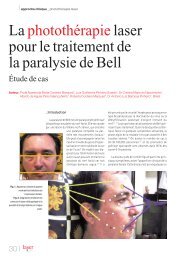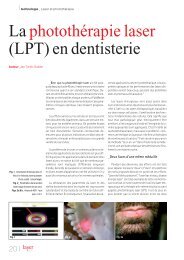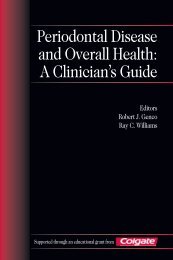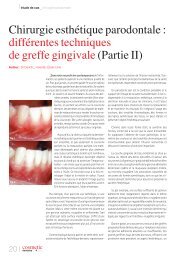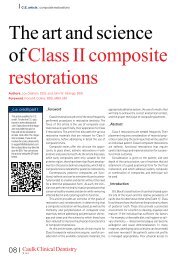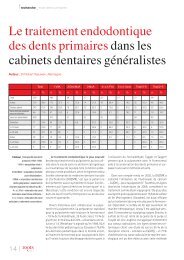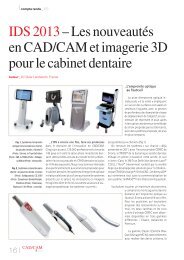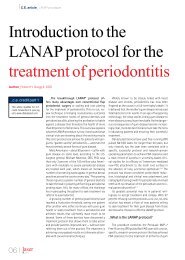The Role of Antimicrobial Mouth Rinses in Infection Prevention
The Role of Antimicrobial Mouth Rinses in Infection Prevention
The Role of Antimicrobial Mouth Rinses in Infection Prevention
You also want an ePaper? Increase the reach of your titles
YUMPU automatically turns print PDFs into web optimized ePapers that Google loves.
guidel<strong>in</strong>es for antibiotic prophylaxis, the American Heart Association (AHA) recommended the<br />
use <strong>of</strong> pre-procedural mouth r<strong>in</strong>ses for patients at risk for bacteremia dur<strong>in</strong>g dental procedures.<br />
In its most current guidel<strong>in</strong>es, the AHA does not mention pre-procedural mouth r<strong>in</strong>s<strong>in</strong>g. In<br />
addition, the American Academy <strong>of</strong> Orthopaedic Surgeons (AAOS) also states <strong>in</strong> their 2012<br />
guidel<strong>in</strong>es on <strong>Prevention</strong> <strong>of</strong> Orthopaedic Implant <strong>Infection</strong> <strong>in</strong> Patients Undergo<strong>in</strong>g Dental<br />
Procedures that the evidence is <strong>in</strong>conclusive to support the use <strong>of</strong> topical antimicrobials (mouth<br />
r<strong>in</strong>ses) to prevent orthopaedic implant <strong>in</strong>fections. Further study is needed to determ<strong>in</strong>e the<br />
effectiveness <strong>of</strong> pre-procedural mouth r<strong>in</strong>s<strong>in</strong>g for reduc<strong>in</strong>g dental procedure-<strong>in</strong>duced bacteremia<br />
and the <strong>in</strong>cidence <strong>of</strong> bacteremia <strong>in</strong> patients who have underly<strong>in</strong>g risks.<br />
<strong>Mouth</strong> <strong>R<strong>in</strong>ses</strong> for Environmental <strong>Infection</strong> Control<br />
<strong>The</strong> third issue related to pre-procedural mouth r<strong>in</strong>s<strong>in</strong>g is that <strong>of</strong> reduc<strong>in</strong>g the number <strong>of</strong> bacteria<br />
<strong>in</strong> the saliva dur<strong>in</strong>g dental procedures that <strong>in</strong>volve the creation <strong>of</strong> aerosols, spatter and spray.<br />
<strong>The</strong>se procedures <strong>in</strong>clude the use <strong>of</strong> a high and slow speed handpieces, air/water syr<strong>in</strong>ges and<br />
ultrasonic scalers. <strong>The</strong> most effective way to reduce the aerosol and spatter contam<strong>in</strong>ation is to<br />
use a dental dam. But a dental dam would <strong>in</strong>terfere with hygiene procedures, such as ultrasonic<br />
scal<strong>in</strong>g and polish<strong>in</strong>g. And the use <strong>of</strong> dental dam for restorative procedures may take additional<br />
time and <strong>in</strong>strumentation that many practices choose not to adapt <strong>in</strong>to their protocols. In this<br />
case, a pre-procedural antibacterial mouth r<strong>in</strong>se is a simple way to decrease the potential for<br />
aerosol contam<strong>in</strong>ation <strong>in</strong> the treatment rooms.<br />
While the Centers for Disease Control and <strong>Prevention</strong> (CDC) does not specifically recommend<br />
pre-procedural mouthr<strong>in</strong>ses as an <strong>in</strong>fection prevention protocol, there is evidence that us<strong>in</strong>g an<br />
antimicrobial mouthr<strong>in</strong>se prior to procedures can reduce the potential for is contam<strong>in</strong>ation <strong>of</strong><br />
equipment and environmental surfaces. Accord<strong>in</strong>g to the CDC, the spray from dental<br />
procedures typically conta<strong>in</strong>s large-particle spatter or spray <strong>of</strong> water, saliva, blood,<br />
microorganisms and other debris (tooth, restorative material, calculus). <strong>The</strong> spatter has been<br />
shown to travel only short distances from the patient’s mouth, which would potentially<br />
contam<strong>in</strong>ate equipment (e.g. bracket tray), operatory surfaces (counter tops or other work<br />
surfaces) and the dental team members and patients. Aerosol, on the other hand is composed<br />
<strong>of</strong> much smaller particles and can rema<strong>in</strong> airborne for long periods <strong>of</strong> time and can pose an<br />
<strong>in</strong>halation risk for dental team members. It is important to note, however, that there is no<br />
evidence <strong>of</strong> transmission <strong>of</strong> bloodborne pathogens, such as hepatitis B or C or HIV/AIDS<br />
through exposure to aerosol or spatter <strong>in</strong> dentistry. <strong>The</strong> use <strong>of</strong> pre-procedural mouthr<strong>in</strong>ses is an<br />
additional safeguard that could be employed by dental practices for protection aga<strong>in</strong>st other<br />
types <strong>of</strong> microorganisms, such as the <strong>in</strong>fluenza virus. But dental teams should utilize dental<br />
dams and high volume evacuation as their first l<strong>in</strong>e <strong>of</strong> defense aga<strong>in</strong>st spatter and<br />
aerosolization <strong>of</strong> saliva and blood dur<strong>in</strong>g dental procedures. It is also important to note that the<br />
use <strong>of</strong> pre-procedural mouthr<strong>in</strong>ses does not preclude the need for environmental clean<strong>in</strong>g and<br />
dis<strong>in</strong>fection <strong>of</strong> equipment and surfaces follow<strong>in</strong>g treatment. Although the mouthr<strong>in</strong>se may<br />
www.ColgateOralHealthNetwork.com<br />
Web<strong>in</strong>ars | On-Demand Courses | Articles | Textbooks 5



